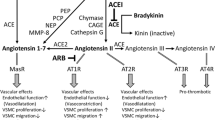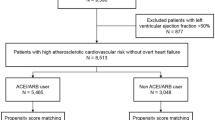Abstract
Angiotensin-converting enzyme (ACE) inhibitors improve outcomes in patients with coronary artery disease (CAD), heart failure, and hypertension. This short review examines clinical evidence for such effects and the underlying mechanism of action. One potential mode of action for ACE inhibitors in CAD is blood pressure reduction. However, recent data suggest that the effects of ACE inhibitors on the endothelium may also be relevant in attenuating the progression of atherosclerosis. In CAD, chronic overexpression of tissue ACE disrupts the angiotensin II/bradykinin balance with a net result of endothelial dysfunction, mainly due to an increased rate of apoptosis. An imbalance between endothelial apoptosis (death) and its renewal from the bone marrow (life) causes discontinuity of the endothelial layer, favoring the initiation and progression of a biochemical sequence that leads to atherosclerosis, plaque rupture, and eventually acute coronary syndromes. There is clinical and experimental evidence that ACE inhibition improves the life and death cycle of the endothelium. By restoring the bradykinin/angiotensin II balance, ACE inhibition reduces the rate of endothelial apoptosis and experimental results suggest that ACE inhibition can also improve the production and mobilization of endothelial progenitor cells from bone marrow. We report our experience in this context with perindopril.





Similar content being viewed by others
References
Ferrari R. Cardiovascular protection by angiotensin-converting enzyme inhibition. Eur Heart J Suppl. 2009;11:E1–3.
Ferrari R, Fox K. Insight into the mode of action of ACE inhibition in coronary artery disease: the ultimate ‘EUROPA’ story. Drugs. 2009;69:265–77.
Ceconi C, Fox KM, Remme WJ, et al. ACE inhibition with perindopril and endothelial dysfunction. Results of a substudy of the EUROPA study: PERTINENT. Cardiovasc Res. 2007;73:237–46.
Mancia G, De Backer G, Dominiczak A, et al. 2007 Guidelines for the management of arterial hypertension: the Task Force for the Management of Arterial Hypertension of the European Society of Hypertension (ESH) and of the European Society of Cardiology (ESC). Eur Heart J. 2007;28:1462–536.
Mancia G, Laurent S, Gabiti-Rosei E, et al. Reappraisal of European guidelines on hypertension management: a European Society of Hypertension Task Force document. J Hypertens. 2009;27:2121–58.
Cordonnier DJ, Pinel N, Barro C, et al. Expansion of cortical interstitium is limited by converting enzyme inhibition in type 2 diabetic patients with glomerulosclerosis. The Diabiopsies Group. J Am Soc Nephrol. 1999;10:1253–63.
Jerums G, Allen TJ, Campbell DJ, et al. Long-term comparison between perindopril and nifedipine in normotensive patients with type 1 diabetes and microalbuminuria. Am J Kidney Dis. 2001;37:890–9.
Dahlof B, Sever PS, Poulter NR, et al. Prevention of cardiovascular events with an antihypertensive regimen of amlodipine adding perindopril as required versus atenolol adding bendroflumethiazide as required, in the Anglo-Scandinavian Cardiac Outcomes Trial-Blood Pressure Lowering Arm (ASCOT-BPLA): a multicentre randomised controlled trial. Lancet. 2005;366:895–906.
Patel A, MacMahon S, Chalmers J, et al. Effects of a fixed combination of perindopril and indapamide on macrovascular and microvascular outcomes in patients with type 2 diabetes mellitus (the ADVANCE trial): a randomised controlled trial. Lancet. 2007;370:829–40.
Dyker AG, Grosset DG, Lees K. Perindopril reduces blood pressure but not cerebral blood flow in patients with recent cerebral ischemic stroke. Stroke. 1997;28:580–3.
Nazir FS, Overell JR, Bolster A, Hilditch TE, Lees KR. Effect of perindopril on cerebral and renal perfusion on normotensives in mild early ischaemic stroke: a randomized controlled trial. Cerebrovasc Dis. 2005;19:77–83.
PROGRESS Collaborative Group. Randomised trial of a perindopril-based blood-pressure-lowering regimen among 6, 105 individuals with previous stroke or transient ischaemic attack. Lancet. 2001;358:1033–41.
Management of stable angina pectoris. Recommendations of the Task Force of the European Society of Cardiology. Eur Heart J. 2006;27:1341–81.
Rosamond W, Flegal K, Furie K, et al. Heart disease and stroke statistics 2008 update. A report from the American Heart Association Statistics Committee and Stroke Statistics Subcommittee. Circulation. 2008;117:25–146.
Yusuf S, Sleight P, Pogue J, Bosch J, Davies R, Dagenais G. Effects of an angiotensin-converting-enzyme inhibitor, ramipril, on cardiovascular events in high-risk patients. The Heart Outcomes Prevention Evaluation Study Investigators. N Engl J Med. 2000;342:145–53.
The EURopean trial On reduction of cardiac events with Perindopril in stable coronary Artery disease Investigators. Efficacy of perindopril in reduction of cardiovascular events among patients with stable coronary artery disease: randomised, double-blind, placebo-controlled, multicentre trial (the EUROPA study). Lancet. 2003;362:782–8.
Pitt B, O’Neill B, Feldman R, et al. The QUinapril Ischemic Event Trial (QUIET): evaluation of chronic ACE inhibitor therapy in patients with ischemic heart disease and preserved left ventricular function. Am J Cardiol. 2001;87:1058–63.
Braunwald E, Domanski MJ, Fowler SE, et al. Angiotensin-converting-enzyme inhibition in stable coronary artery disease. N Engl J Med. 2004;351:2058–68.
Kober L, Torp-Pedersen C, Carlsen JE, et al. A clinical trial of the angiotensin-converting-enzyme inhibitor trandolapril in patients with left ventricular dysfunction after myocardial infarction. Trandolapril Cardiac Evaluation (TRACE) Study Group. N Engl J Med. 1995;333:1670–6.
Remme WJ. Secondary prevention of coronary artery disease and the choice of the ACE inhibitor why EUROPA and not PEACE. Cardiovasc Drugs Ther. 2007;21:405–7.
Deckers JW, Goedhart DM, Boersma E, et al. Treatment benefit by perindopril in patients with stable coronary artery disease at different levels of risk. Eur Heart J. 2006; 27:796–801.
Buemi M, Corica F, Marino D, et al. Cardiovascular remodeling, apoptosis, and drugs. Am J Hypertens. 2000;13:450–4.
Bertrand ME, Remme WJ, Fox KM, Ferrari R, Simoons ML. Effects of perindopril on long-term clinical outcome of patients with coronary artery disease and preserved left ventricular function. Int J Cardiol. 2007;121:57–61.
Fox KM, Bertrand ME, Remme WJ, Ferrari R, Simoons ML, Deckers JW. Efficacy of perindopril in reducing risk of cardiac events in patients with revascularized coronary artery disease. Am Heart J. 2007;153:629–35.
Yusuf S, Pogue J, Myers MG, et al. ACE inhibition in stable coronary artery disease. N Engl J Med. 2005;352:937–9.
Indications for ACE inhibitors in the early treatment of acute myocardial infarction: systematic overview of individual data from 100,000 patients in randomized trials. ACE Inhibitor Myocardial Infarction Collaborative Group. Circulation 1998;97:2202–12.
Ferrari R. Effects of angiotensin-converting enzyme inhibition with perindopril on left ventricular remodeling and clinical outcome: results of the randomized Perindopril and Remodeling in Elderly with Acute Myocardial Infarction (PREAMI) Study. Arch Intern Med. 2006;166:659–66.
Effect of ramipril on mortality and morbidity of survivors of acute myocardial infarction with clinical evidence of heart failure. The Acute Infarction Ramipril Efficacy (AIRE) Study Investigators. Lancet. 1993;342:821–8.
Pfeffer MA, Braunwald E, Moye LA, et al. Effect of captopril on mortality and morbidity in patients with left ventricular dysfunction after myocardial infarction. Results of the survival and ventricular enlargement trial. The SAVE Investigators. N Engl J Med. 1992;327:669–77.
Fox KM. Management of coronary artery disease: implications of the EUROPA trial. Br J Cardiol. 2004;11:195–204.
Van de WF, Ardissino D, Betriu A, et al. Management of acute myocardial infarction in patients presenting with ST-segment elevation. Eur Heart J. 2003;24:28–66.
Jessup M, Brozena S. Heart failure. N Engl J Med. 2003;348:2007–18.
Remme WJ, Deckers JW, Fox KM, Ferrari R, Bertrand M, Simoons ML. Secondary prevention of coronary disease with ACE inhibition–does blood pressure reduction with perindopril explain the benefits in EUROPA? Cardiovasc Drugs Ther. 2009;23:161–70.
Poole Wilson PA, Lubsen J, Kirwan BA, et al. Effect of long-acting nifedipine on mortality and cardiovascular morbidity in patients with stable angina requiring treatment (ACTION trial): randomised controlled trial. Lancet. 2004;364:849–57.
Dzau VJ, Bernstein K, Celermajer D, et al. Pathophysiologic and therapeutic importance of tissue ACE: a consensus report. Cardiovasc Drugs Ther. 2002;16:149–60.
Esther CR, Marino EM, Howard TE, et al. The critical role of tissue angiotensin-converting enzyme as revealed by gene targeting in mice. J Clin Invest. 1997;99:2375–85.
Falk E. Pathogenesis of atherosclerosis. J Am Coll Cardiol. 2006;47:C7–C12.
Hoshida S, Kato J, Nishino M, et al. Increased angiotensin-converting enzyme activity in coronary artery specimens from patients with acute coronary syndrome. Circulation. 2001;103:630–3.
Ferrari R, Guardigli G, Mele D, Valgimigli M, Ceconi C. Myocardial ischaemia: new evidence for angiotensin-converting enzyme inhibition. Eur Heart J. 2003;5:E11–7.
Ferrari R. Angiotensin-converting enzyme inhibition in cardiovascular disease: evidence with perindopril. Expert Rev Cardiovasc Ther. 2005;3:15–29.
Bots ML, Remme WJ, Luscher TF, et al. ACE inhibition and endothelial function: main findings of PERFECT, a sub-study of the EUROPA trial. Cardiovasc Drugs Ther. 2007;21:269–79.
Rodriguez-Granillo GA, Vos J, Bruining N, et al. Long-term effect of perindopril on coronary atherosclerosis progression (from the PERindopril’s Prospective Effect on Coronary aTherosclerosis by Angiography and IntraVascular Ultrasound Evaluation [PERSPECTIVE] Study). Am J Cardiol. 2007;100:159–63.
Rodriguez-Granillo GA, De Winter S, Bruining N, et al. Effect of perindopril on coronary remodelling: insights from a multicentre, randomized study. Eur Heart J. 2007;28:2326–31.
Daly CA, Fox KM, Remme WJ, Bertrand ME, Ferrari R, Simoons ML. The effect of perindopril on cardiovascular morbidity and mortality in patients with diabetes in the EUROPA study: results from the PERSUADE substudy. Eur Heart J. 2005;26:1369–78.
Ceconi C, Fox KM, Remme WJ, et al. ACE inhibition with perindopril and biomarkers of atherosclerosis and thrombosis: results from the PERTINENT study. Atherosclerosis. 2009;204:273–5.
Ceconi C, Francolini G, Bastianon D, Gitti GL, Comini L, Ferrari R. Differences in the effect of angiotensin-converting enzyme inhibitors on the rate of endothelial cell apoptosis: in vitro and in vivo studies. Cardiovasc Drugs Ther. 2007;21:423–9.
Ferrari R, Bertrand ME, Remme WJ, Simoons ML, Deckers JW, Fox KM. Insight into ACE inhibition in the prevention of cardiac events in stable coronary artery disease: the EUROPA trial. Expert Rev Cardiovasc Ther. 2007;5:1037–46.
Valgimigli M, Rigolin GM, Fucili A, et al. CD34+ and endothelial progenitor cells in patients with various degrees of congestive heart failure. Circulation. 2004;110:1209–12.
Valgimigli M, Rigolin GM, Cittanti C, et al. Use of granulocyte-colony stimulating factor during acute myocardial infarction to enhance bone marrow stem cell mobilization in humans: clinical and angiographic safety profile. Eur Heart J. 2005;26:1838–45.
Acknowledgments
The study was supported by a Regional-University project of Emilia Romagna – Area IB – Innovative Research grant.
Conflict of interest
The authors have received honoraria from Servier for being on the Executive Committee of the EUROPA trial and for lectures, and the Foundation Salvatore Maugeri has received research grants from Servier. The authors have no other relevant affiliations or financial involvement with any organization or entity in conflict with the subject matter or materials discussed in the manuscript apart from those disclosed.
Author information
Authors and Affiliations
Corresponding author
Rights and permissions
About this article
Cite this article
Ferrari, R., Guardigli, G. & Ceconi, C. Secondary Prevention of CAD with ACE Inhibitors: A Struggle Between Life and Death of the Endothelium. Cardiovasc Drugs Ther 24, 331–339 (2010). https://doi.org/10.1007/s10557-010-6244-x
Published:
Issue Date:
DOI: https://doi.org/10.1007/s10557-010-6244-x




